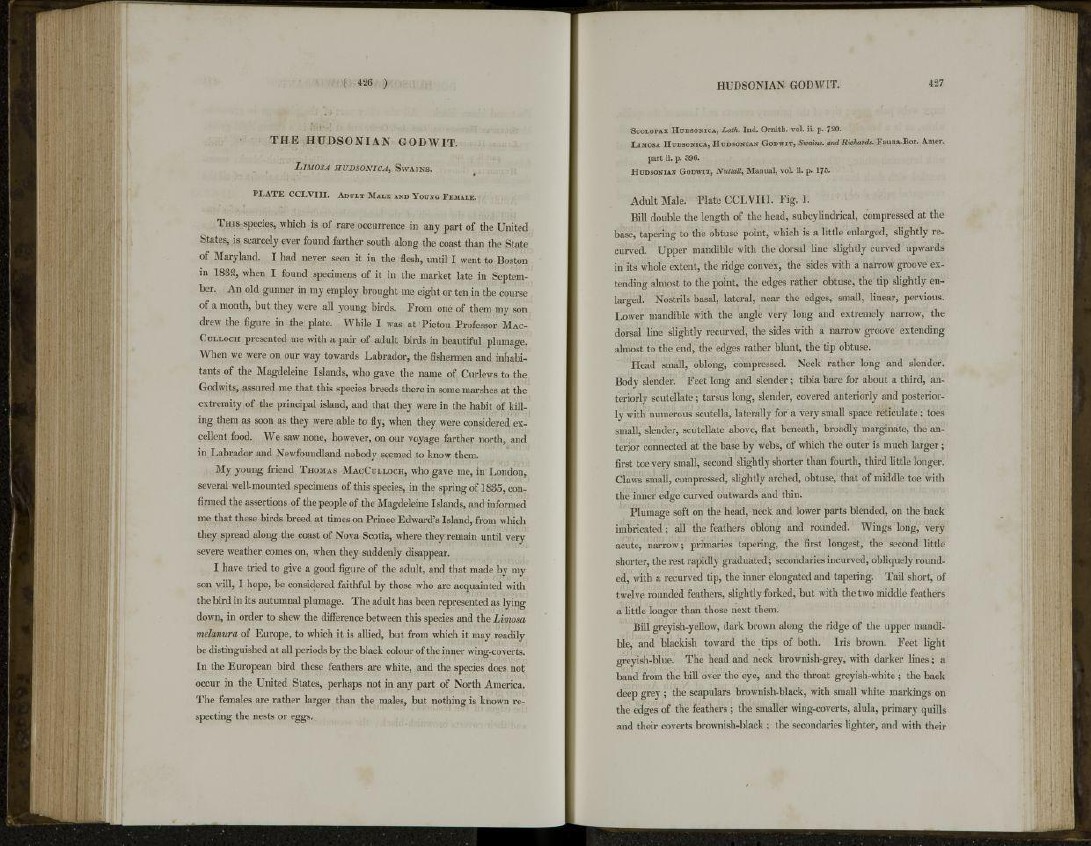
THE HUDSONIAN GODWIT.
LlMOSA HUDSONICA, SwAINS.
PLATE CCLVIII. ADULT MALE AND YOUNG FEMALE.
T H I S species, which is of rare occurrence in any part of the United
States, is scarcely ever found farther south along the coast than the State
of Maryland. I had never seen it in the flesh, until I went to Boston
in 1832, when I found specimens of it in the market late in September.
An old gunner in my employ brought me eight or ten in the course
of a month, but they were all young birds. From one of them my son
drew the figure in the plate. While I was at Pictou Professor MACCULLOCH
presented me with a pair of adult birds in beautiful plumage.
When we were on our way towards Labrador, the fishermen and inhabitants
of the Magdeleine Islands, who gave the name of Curlews to the
God wits, assured me that this species breeds there in some marshes at the
extremity of the principal island, and that they were in the habit of killing
them as soon as they were able to fly, when they were considered excellent
food. We saw none, however, on our voyage farther north, and
in Labrador and Newfoundland nobody seemed to know them.
My young friend THOMAS MACCULLOCH, who gave me, in London,
several well-mounted specimens of this species, in the spring of 1835, confirmed
the assertions of the people of the Magdeleine Islands, and informed
me that these birds breed at times on Prince Edward's Island, from which
they spread along the coast of Nova Scotia, where they remain until very
severe weather comes on, when they suddenly disappear.
I have tried to give a good figure of the adult, and that made by my
son will, I hope, be considered faithful by those who are acquainted with
the bird in its autumnal plumage. The adult has been represented as lying
down, in order to shew the difference between this species and the Limosa
melanura of Europe, to which it is allied, but from which it may readily
be distinguished at all periods by the black colour of the inner wing-coverts.
In the European bird these feathers are white, and the species does not
occur in the United States, perhaps not in any part of North America.
The females are rather larger than the males, but nothing is known respecting
the nests or eggs.
SCOLOPAX HUDSONICA, Lath. Ind. Ornith. vol. ii. p. 720.
LIMOSA HUDSONICA, HUDSONIAN GODWIT, Swains, and Richards. Fauna-Bor. Amer.
part ii. p. 396.
HUDSONIAN GODWIT, Nuttall, Manual, vol. ii. p. 175.
Adult Male. Plate CCLVIII. Fig. 1.
Bill double the length of the head, subcylindrical, compressed at the
base, tapering to the obtuse point, which is a little enlarged, slightly recurved.
Upper mandible with the dorsal line slightly curved upwards
in its whole extent, the ridge convex, the sides with a narrow groove extending
almost to the point, the edges rather obtuse, the tip slightly enlarged.
Nostrils basal, lateral, near the edges, small, linear, pervious.
Lower mandible with the angle very long and extremely narrow, the
dorsal line slightly recurved, the sides with a narrow groove extending
almost to the end, the edges rather blunt, the tip obtuse.
Head small, oblong, compressed. Neck rather long and slender.
Body slender. Feet long and slender; tibia bare for about a third, anteriorly
scutellate; tarsus long, slender, covered anteriorly and posteriorly
with numerous scutella, laterally for a very small space reticulate; toes
small, slender, scutellate above, flat beneath, broadly marginate, the anterior
connected at the base by webs, of which the outer is much larger;
first toe very small, second slightly shorter than fourth, third little longer.
Claws small, compressed, slightly arched, obtuse, that of middle toe with
the inner edge curved outwards and thin.
Plumage soft on the head, neck and lower parts blended, on the back
imbricated; all the feathers oblong and rounded. Wings long, very
acute, narrow; primaries tapering, the first longest, the second little
shorter, the rest rapidly graduated; secondaries incurved, obliquely rounded,
with a recurved tip, the inner elongated and tapering. Tail short, of
twelve rounded feathers, slightly forked, but with the two middle feathers
a little longer than those next them.
Bill greyish-yellow, dark brown along the ridge of the upper mandible,
and blackish toward the tips of both. Iris brown. Feet light
greyish-blue. The head and neck brownish-grey, with darker lines; a
band from the bill over the eye, and the throat greyish-white ; the back
deep grey; the scapulars brownish-black, with small white markings on
the edges of the feathers ; the smaller wing-coverts, alula, primary quills
and their coverts brownish-black ; the secondaries lighter, and with their